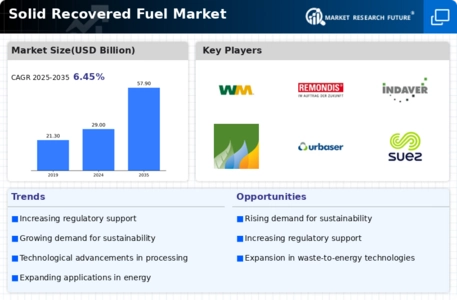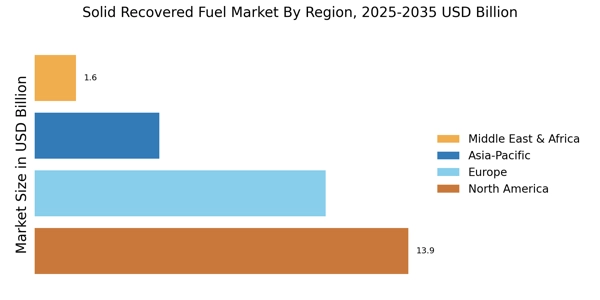Technological Innovations in Production
Technological advancements play a crucial role in shaping the Solid Recovered Fuel Market. Innovations in production processes, such as advanced sorting and processing technologies, enhance the efficiency and quality of solid recovered fuels. These technologies enable the extraction of high-energy content materials from waste, thereby increasing the overall yield of solid recovered fuels. Furthermore, the integration of automation and artificial intelligence in production facilities is likely to streamline operations, reduce costs, and improve product consistency. As a result, the market is expected to witness a surge in the adoption of solid recovered fuels, with projections indicating a potential increase in market size by approximately 10% within the next five years. This technological evolution not only supports the growth of the industry but also aligns with the global shift towards more sustainable energy solutions.
Growing Demand for Renewable Energy Sources
The Solid Recovered Fuel Market is significantly influenced by the rising demand for renewable energy sources. As countries strive to meet their energy needs while minimizing environmental impact, solid recovered fuels emerge as a compelling alternative. The increasing awareness of climate change and the need for sustainable energy solutions are driving industries to seek out renewable options. Reports indicate that the market for solid recovered fuels could expand by 15% over the next decade, driven by this growing demand. Industries such as cement and power generation are particularly keen on integrating solid recovered fuels into their energy mix, as they offer a reliable and cost-effective solution. This trend not only supports energy diversification but also contributes to the reduction of greenhouse gas emissions, further solidifying the role of solid recovered fuels in the energy landscape.
Regulatory Support for Sustainable Practices
The Solid Recovered Fuel Market is experiencing a notable boost due to increasing regulatory support for sustainable waste management practices. Governments are implementing stringent regulations aimed at reducing landfill waste and promoting recycling initiatives. This regulatory framework encourages industries to adopt solid recovered fuels as a viable alternative to fossil fuels. For instance, policies that mandate the use of renewable energy sources in industrial processes are likely to drive demand for solid recovered fuels. As a result, the market is projected to grow significantly, with estimates suggesting a compound annual growth rate of around 5% over the next few years. This regulatory environment not only fosters innovation but also enhances the overall sustainability of energy production, making solid recovered fuels an attractive option for many sectors.
Economic Benefits of Waste-to-Energy Solutions
The Solid Recovered Fuel Market is also propelled by the economic advantages associated with waste-to-energy solutions. Utilizing solid recovered fuels not only helps in waste management but also provides a cost-effective energy source for various industries. By converting waste into energy, companies can reduce their reliance on traditional fossil fuels, which are subject to price volatility. This economic incentive is particularly appealing in sectors such as manufacturing and construction, where energy costs constitute a significant portion of operational expenses. Furthermore, the potential for job creation in the waste management and energy sectors adds another layer of economic benefit. As the market evolves, it is anticipated that the adoption of solid recovered fuels will lead to a more resilient energy economy, with projections suggesting a market growth rate of around 7% in the coming years.
Increased Investment in Waste Management Infrastructure
The Solid Recovered Fuel Market is witnessing increased investment in waste management infrastructure, which is crucial for the development and expansion of solid recovered fuels. Governments and private entities are recognizing the need for modernized waste processing facilities that can efficiently convert waste into energy. This investment not only enhances the capacity for producing solid recovered fuels but also improves the overall efficiency of waste management systems. As infrastructure improves, the quality and availability of solid recovered fuels are likely to increase, making them more attractive to potential users. Analysts predict that this trend could lead to a market growth of approximately 8% over the next few years, as enhanced infrastructure supports the broader adoption of solid recovered fuels across various industries.


















Leave a Comment